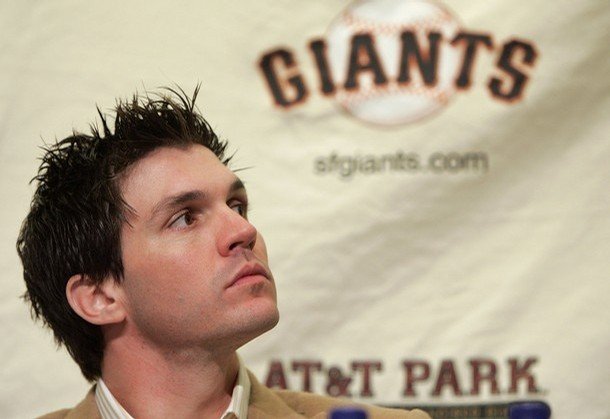I tried to represent as many different sports as possible when I put together The Best Sports Writing of Pat Jordan. Funny thing is, while there may be more great writing about boxing than any other sport, including baseball, no boxing stories made the cut, though Pat’s done some decent ones, like this one about Amir Khan, the Great British-Pakistani-Muslim Hope:
At 10 p.m., Amir Khan walked into the arena amid the flash of cameras and TV lights and the Asian girls aiming their cellphone cameras at him. He was wearing his trademark silver trunks, but with a slight alteration: tartan trim had been sewn in. Steve Gethin stood in his corner, his blue eyes wide.
The bell rang for Round 1. Khan loped into the center of the ring and began to stalk Gethin. He moved gracefully, bent over at the waist, bobbing and weaving left and right, his hands dangling low to the canvas. Khan did not look so young now, nor so slight. He looked huge next to Gethin and dangerous in a primitive way. Suddenly he attacked Gethin, hitting him with three quick punches before Gethin could react. Khan did resemble Muhammad Ali in the ring. It’s almost sinuous, the way he moves. He’s a trained fighter, but an instinctive one too.
Khan pursued Gethin, who backpedaled, Khan weaving hypnotically, and then he sprang again, pummeling Gethin with so many quick punches it seemed as if they were all one long, continuous punch. Gethin wrapped his arms around Khan and waited for the referee to separate them.
The fight didn’t last very long. The referee stopped it in the third round, after Khan again battered Gethin’s head with so many quick blows in succession that Gethin could only cover his face with his gloves and forsake any thought of throwing a counterpunch.
Khan raised his arms in victory. Some cheered; others were upset the fight had been stopped early. The members of “Khan’s Barmy Army” poured out of their seats. They began to leave the arena, waving their Union Jack-Pakistani flag at the seated fans. The Scottish fans began to throw things at them. Bottles. Sharpened coins. Cups of beer. “Khan’s Barmy Army” covered their heads. Security appeared from the runways, surrounded Khan’s “army” and hustled them out of the arena. In the ring, Amir Khan, oblivious, was being interviewed on ITV with his father.
Pat did a handful of hockey pieces for Sports Illustraed in the ’70s including a good one on Derek Sanderson. We included a hockey story in our collection, one of his earliest pieces for Sport magazine, about the Bruins at the old Boston Garden. Here is a good little profile Jordan did on Mike Keenan for The Sporting News in 1994, just after coach Keenan left the Rangers for St. Louis.
Italian waiters at Gian-Peppe’s Restaurant in “The Hill” section of St. Louis are wearing tuxedos with frilly shirts. They hover around Keenan at his table as if he were the Mafia Don out of “A Bronx Tale.”
“I used to hang around with seven Italian brothers when I was a kid,” he says. “I was the only Irish kid. If they got a beating from their mother, I got a beating from her, too.” He laughs, and drains his beer. Keenan asks a waiter to bring him a phone. He has to call his daughter, who will visit him tomorrow, and he’s worried that she might not have gotten the airplane ticket he sent her.
“It causes me great pain to be away from her,” he says, as the waiter returns with the phone. “I’m proud of my accomplishments, but maybe my ambition was selfish. You pay a personal price. Loneliness. It’s the only thing that scares me.” He makes the call, but his daughter is not home. The other waiter returns with a beer. For a tough-guy hockey coach, Keenan talks a lot about pain and lone-liness and even fear. He had a fear of failure when he took over at Philadelphia.
“I was confident,” he says. “I felt ready. But there’s always that fear in hockey if you’re not successful you’ll never coach again. I felt I had to be firm with my players and then I’d back off after a while, you know, the way a teacher does. But the players didn’t think I let up as much as I should have. I like to think my relationship with players has improved. I’ve improved. After the separation, I learned to reflect on life. To be introspective, tolerant and understanding. It was an awakening.” He picks up the phone and dials his daughter again.
I’m not a hockey fan and I never have been. I don’t follow boxing but I liked it as a kid. Hagler, Hearns, Sugar Ray. The tail end of Ali. The Rocky movies (seeing Rocky III in the balcony of Loews 83rd street–a theater no longer with us–with the place literally shaking during the big fight at the end, was one of the more memorable movie experiences of my childhood). Larry Holmes v. Tim Witherspoon, vs. R. Tex Cobb, all the way through Iron Mike’s early days.
I want to read more boxing writing at some point–there’s so much good stuff out there. I’d at least like to give it a shot. It’s such an appealing sport for writers because, as Len Shapiro of the Washington Post says, “It’s the greatest sport in the world until they get in the ring.”
Lot of good boxing movies too, come to think of it: Body and Soul, Somebody Up There Likes Me, Fat City, Rocky, Raging Bull, When We Were Kings. And Slap Shot is arguably the greatest sports movie of them all.













